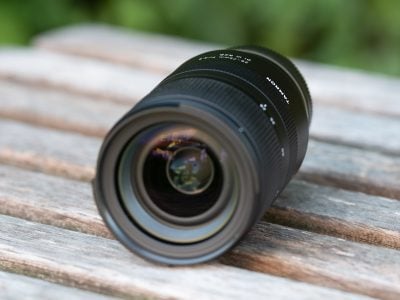Tamron 28-75mm f2.8 review
-
-
Written by Thomas
In depth
The Tamron 28-75mm f2.8 Di III RXD is a small and light non-stabilized standard zoom lens with a constant f2.8 focal ratio that’s designed for Sony E-mount full-frame cameras. Announced in April 2018 it is a successor of sorts to Tamron’s earlier SP AF 28-75mm 2.8 XR Di LD Asp IF Macro which was available for Canon EF, Nikon F, Pentax K and Sony A mount.
The 28-75mm f2.8 Di III RXD is Tamron’s first native e-mount lens and pitched as an alternative to Sony’s general-purpose zooms. The constant f2.8 focal ratio makes it a classier option than Sony’s entry-level kit zoom, the FE 28-70mm f3.5-5.6, and while it’s roughly twice the price, it remains comfortably in three figures. Crucially, it’s less than half the price of Sony’s high-end FE 24-70mm f2.8 G Master. Indeed price-wise, it’s closest to Sony’s FE 24-70mm f4 ZA, a Zeiss design that’s s whole stop slower in aperture.
To find out whether the new Tamron 28-75mm f2.8 rightfully earns a recommendation I tested it on the 42MP Sony A7Rii body. Note: while Gordon has reviewed a number of e-mount lenses with his own tests, this is my first e-mount review, so I don’t have any personal results for lenses sharing the same mount yet. So for this first one, I thought it would be interesting to compare it against another first system lens, the Nikon Z 24-70mm f4S. This is obviously just out of interest and no-one is likely to change systems based on it, but equally it is interesting to compare the potentials and options for multiple systems. So if you’re interested in how Tamron’s new standard zoom lens performs, you’ve come to the right place!
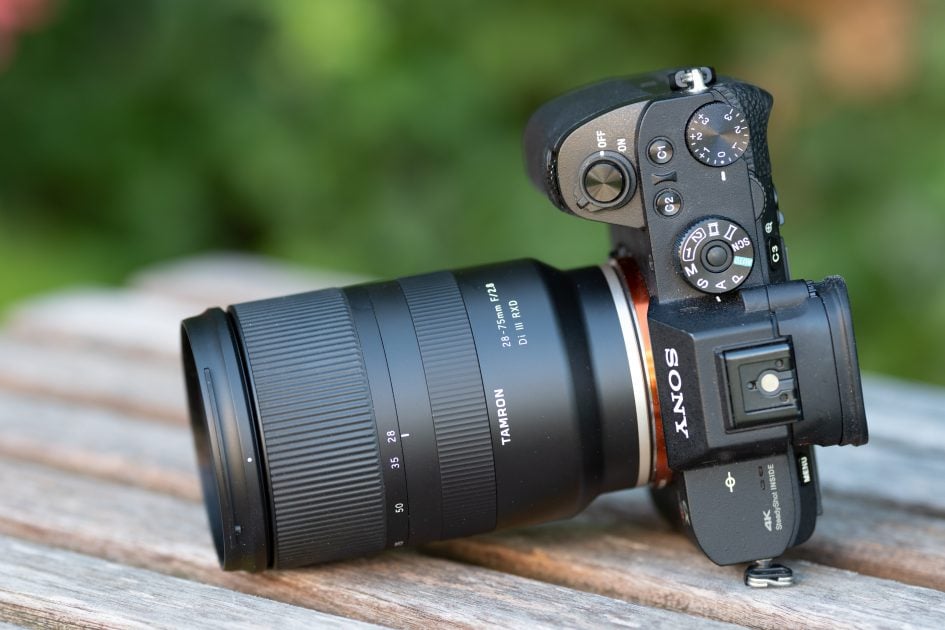
Facts from the catalog
As usual I’ll have a look at the technical data of the new Tamron 28-75mm f2.8 first. I’ve rated the features with a [+] (or [++]), when it’s better than average or even state of the art, a [0] if it’s standard or just average, and [-] if there’s a disadvantage. For comparison I use the only other E-mount f2.8 standard zoom lens, the Sony FE 24-70mm 2.8 GM (“Sony GM” for short), and the Nikon Z 24-70mm f4S (“Z Nikkor” for short).
Size (diameter x length): 73 x 118mm (2.9 x 4.6in.) plus 27mm for the lens hood which is 87mm in diameter. Zooming out to 75mm adds another 25mm which brings the lens up to a total length of 170mm (6.7in.) with lens hood attached. The Sony GM is 88 x 136mm at its shortest without lens hood. The Z Nikkor is 78 x 88mm in its collapsed state plus 41mm for the lens hood. Zooming to 70mm brings the Nikon up to a total length of 179mm with lens hood attached. So the new Tamron is a comparably slim and short lens, especially considering its f2.8 aperture. [+]
Weight: 540g (19.0 oz.) plus 25g for the lens hood. The Sony GM is 886g, the Z Nikkor 497g plus 28g for the lens hood. But this comparison favours the Z Nikkor unfairly as it has only a focal ratio of f4.0. [+]
Optics: 15 elements (including 2 special dispersion and 3 aspherical elements) in 12 groups. This is similar to the Z Nikkor (14/11) while the Sony GM has a more complex optical design (18/13). [+]
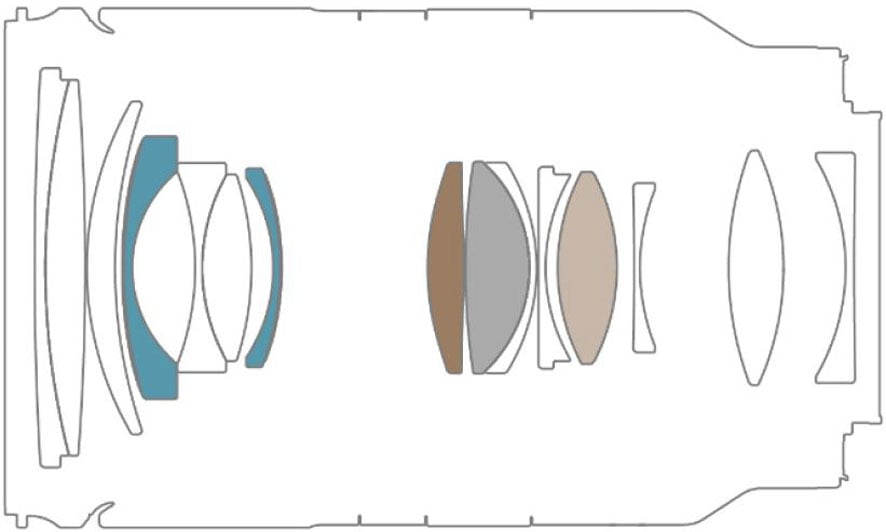
Closest focus distance is 0.39m (15in.) with a magnification of 1:4 at 75mm focal length. In my test I was able to get down to 1:3.8 with manual focus. At the wide end the new Tamron even goes down to 1:2.9 which is quite good but you have only 5.4cm (2.1in.) of working distance at minimum focus distance. At 75mm focal length the working distance is at least 21cm (8.3in.) which is much more usable. A magnification of 1:10 is achieved at 0.86m (2.8ft.) giving a working distance of 0.67m (2.2ft.) with lens hood attached. The Z Nikkor achieves a magnification of 1:3.1 at 0.29m while the Sony GM goes down to 1:4.2 at 0.38m. [+]
Filter-thread: 67mm which is much smaller and cheaper than the 82mm filters the Sony GM needs. The Z Nikkor uses 72mm filters. [+]
Image stabilization: The lens itself offers no optical stabilization just like the Sony GM and the Z Nikkor. But the Sony bodies provide built-in sensor-shift stabilization over 5 axis. [0]
Auto focus: Yes. Manual-focus override is by simply turning the focus ring. The focus ring has a variable gearing that allows for very precise manual focus when turned slowly just like the Sony GM and the Z Nikkor. The Sony GM has an additional focus hold button. [+]
Covers full frame or smaller. Same with the competition. [+]
Price: The new Tamron is currently around 800 EUR (incl. 19% VAT) / 800 USD. This is roughly twice the pricer of Sony’s entry-level FE 28-70mm f3.5-5.6, but less than half that of the Sony G-Master which goes for a whopping 2020 EUR / 2200 USD. It’s roughly similar in price to the Sony FE 24-70mm f4 ZA model. Meanwhile the Z Nikkor has a list price of 1099 EUR / 999 USD. But if you buy it in a kit together with the Nikon Z7 camera it’s only an additional 600 EUR / 750 USD. [+]
Comes without pouch/strap but the lens hood is included and reversible for transport. The Sony GM has a nice lens case and its lens hood locks in place to avoid accidentally falling off. The Z Nikkor has only a soft lens pouch. [0]
Distance information is relayed to the camera, so the camera and flashes can do all the advanced exposure-related stuff with this lens. Same for the competition. [+]
Aperture ring: No, just like the Sony GM. The Z Nikkor has a multi-function lens control ring which can be assigned to operate the aperture, exposure compensation or focus – separately for video and stills. [0]
Sealing: yes, a rubber grommet at the lens-mount. Both the Sony GM and the Z Nikkor have further special weather-sealing throughout the construction. [+]
The score in the “features-department” is 0[-]/3[0]/10[+]. So the lens has a very good feature set. Especially noteworthy is its relatively small size and weight considering its constant f2.8 focal ratio. But this is certainly made easier to achieve by giving up 4mm on the short end which reduces the angle of view from 84 degrees for 24mm focal length to 75 degrees for 28mm (see comparison of coverage below).
Two standard zoom lenses for mirrorless full-frame bodies
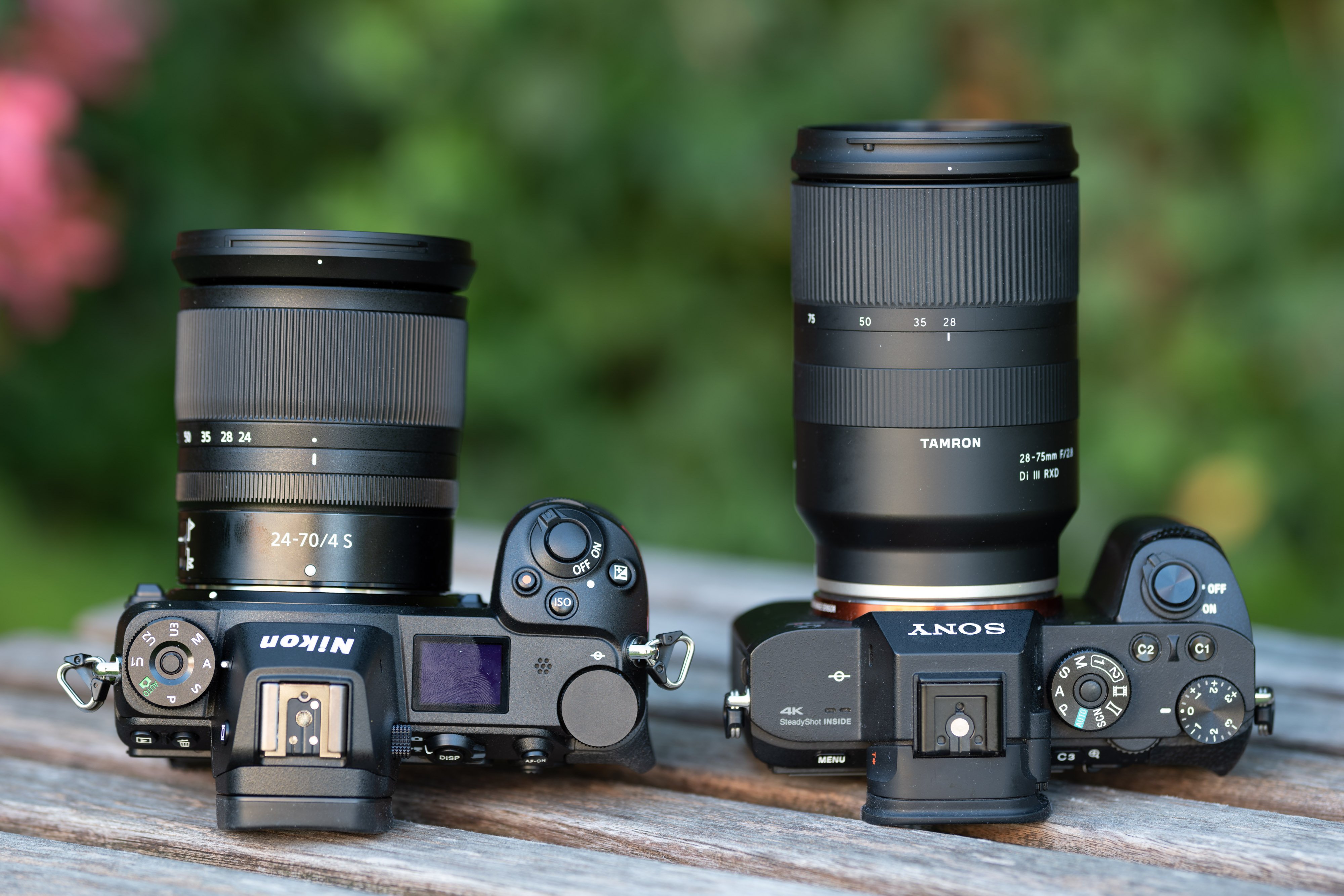
Above: Nikon 24-70mm f4S (left) vs. Tamron 28-75mm f2.8 (right)
Alternatives
The market for full-frame 24-70mm zooms is pretty crowded if you include the A-mount options as they convert quite well. I’ve listed the E-mount options first, excluding the FE 28-70mm kit zoom:
- Sony has the FE 24-70mm f2.8 GM from 2016 for 2020 EUR / 2200 USD. It’s one of Sony’s first G-Master, or GM, lenses, boasting the company’s best optical quality to date. See Gordon’s Sony FE 24-70mm f2.8 GM sample images.
- If you don’t need a focal ratio of f2.8 Sony also offers the stabilized FE 24-70mm f4.0 ZA OSS, which is even smaller and lighter than the new Tamron. It sells for 830 EUR / 900 USD.
- Or you can get the even more versatile Sony FE 24-105mm f4G OSS. It has a 40% longer reach at 105mm focal length plus offers optical stabilization. For more information have a look at Gordon’s Sony FE 24-105mm f4G OSS review so far.
- For A-mount Sony has the 24-70mm f2.8 ZA SSM II from 2015 (2200 EUR / 2100 USD ) and the older 28-75mm f2.8 SAM (2009, 720 EUR / 900 USD).
- Also for A-mount you can still get the older Tamron SP AF 28-75mm 2.8 XR Di LD Asp IF Macro (2003, 400 EUR / 440 USD). And Sigma’s AF 24-70mm f2.8 EX DG HSM from 2009 can still be found in Europe (600 EUR). But as with the old Tamron I’d rather refrain from getting these older designs for use on a modern high megapixel count body.
Here is the angle of view that the new Tamron 28-75mm f2.8 covers with its 2.7x zoom:

Above: Tamron 28-75mm f2.8 coverage on Sony A7Rii full-frame body at 28mm (left) and 75mm (right)
A classic 24-70mm lens captures a visibly wider angle at the short end:

Above: Nikon Z 24-70mm f4S coverage on Nikon Z7 full-frame body at 24mm (left) and 70mm (right)
Focus and zoom
Focus accuracy and repeatability is critical to consistently produce sharp shots. Repeatability (the accuracy of focus on the same subject after repeated focus-acquisition) of this lens at 75mm focal length is good (measured 98.2% in Reikan FoCal) with no outliers over a series of 40 shots on a A7R II. There is a little focus variation with the lens hitting the (focus-) mark better when coming from infinity. At 75mm focal length the lens focuses in around 0.7 sec from infinity to 0.86m (1:10 magnification).
The zoom ring turns through 65 degrees the way Sony (as well as Nikon and Canon) users are used to and has a 29mm wide rubber surface with a good grip. It turns pretty stiff and can hardly be operated with one finger. There is no zoom lock but the operation is stiff enough to prevent zoom creep. The focus ring is 15mm wide and is located closer to the camera. It moves very smooth and can easily be operated with one finger.
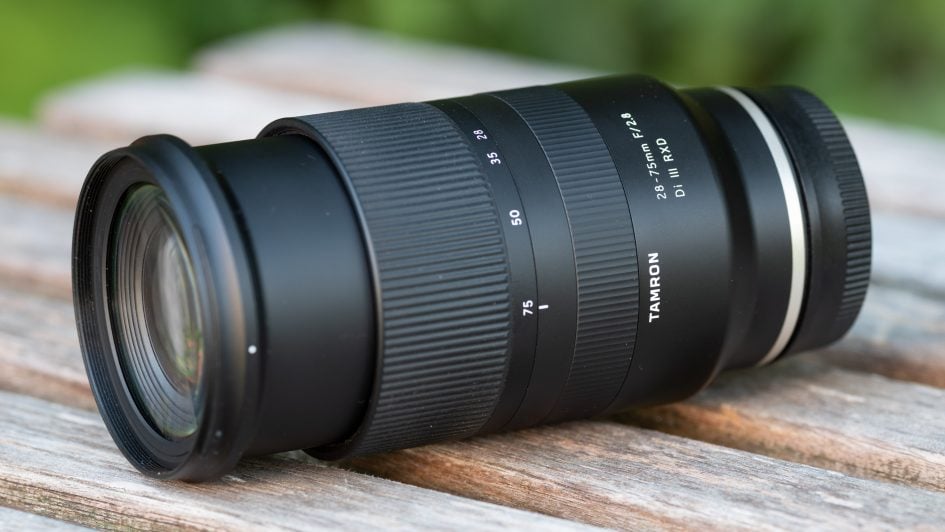
AF-operation of the new lens and image stabilization of the A7R II is inaudible from the outside and when you record video with the built-in microphone. As you pull focus, you’ll notice some focus breathing: the image becomes a little more magnified at closer focusing distances. When I adjusted the focus from infinity to 0.86m (1:10 magnification) on the new Tamron at 75mm focal length, I measured a 3% increase in magnification. The same test at 28mm focal length did only produce a 0,4% increase. Very good! So the new Tamron produces very little focus breathing when recording video.
Image stabilization
To test the effectiveness of image stabilization with the Tamron 28-75mm f2.8 on a Sony A7R II body, I did a series of 140 test-shots hand-held at 75mm focal length. I tested with shutter speeds from 1/80 of a second down to 0.4 sec. Shots at 1/80 sec with Steady Shot=OFF are used as reference of how good my hand-holding was at the time of the test and Reikan FoCal did the chore of evaluating the sharpness of all shots. Here’re the details: With Steady Shot=ON (in camera) the combo produced results down to 1/20 sec (2 stops) which were better or at least comparable to 1/80 sec with Steady Shot=OFF. At 1/10 sec the images were still very usable but clearly less sharp than before. At 1/5 sec there were 50% clearly blurred images. This is a 3 stop advantage from stabilization. On a newer A7R III body the results could be better.
I also tested the new Nikon Z 24-70mm f4S on the Z7 in a test set-up that was identical to the one above. The results: With VR=ON (in camera) the combo produced results down to 1/5 sec (4 stops) which were better or at least comparable to 1/80 sec with VR=OFF. At 0.4 sec there were 30% clearly blurred images. This is a 4-5 stop advantage from stabilization.
Next check out my quality results!
Check prices on the Tamron 28-75mm f2.8 at Amazon, B&H, Adorama, or Wex. Alternatively get yourself a copy of my In Camera book or treat me to a coffee! Thanks!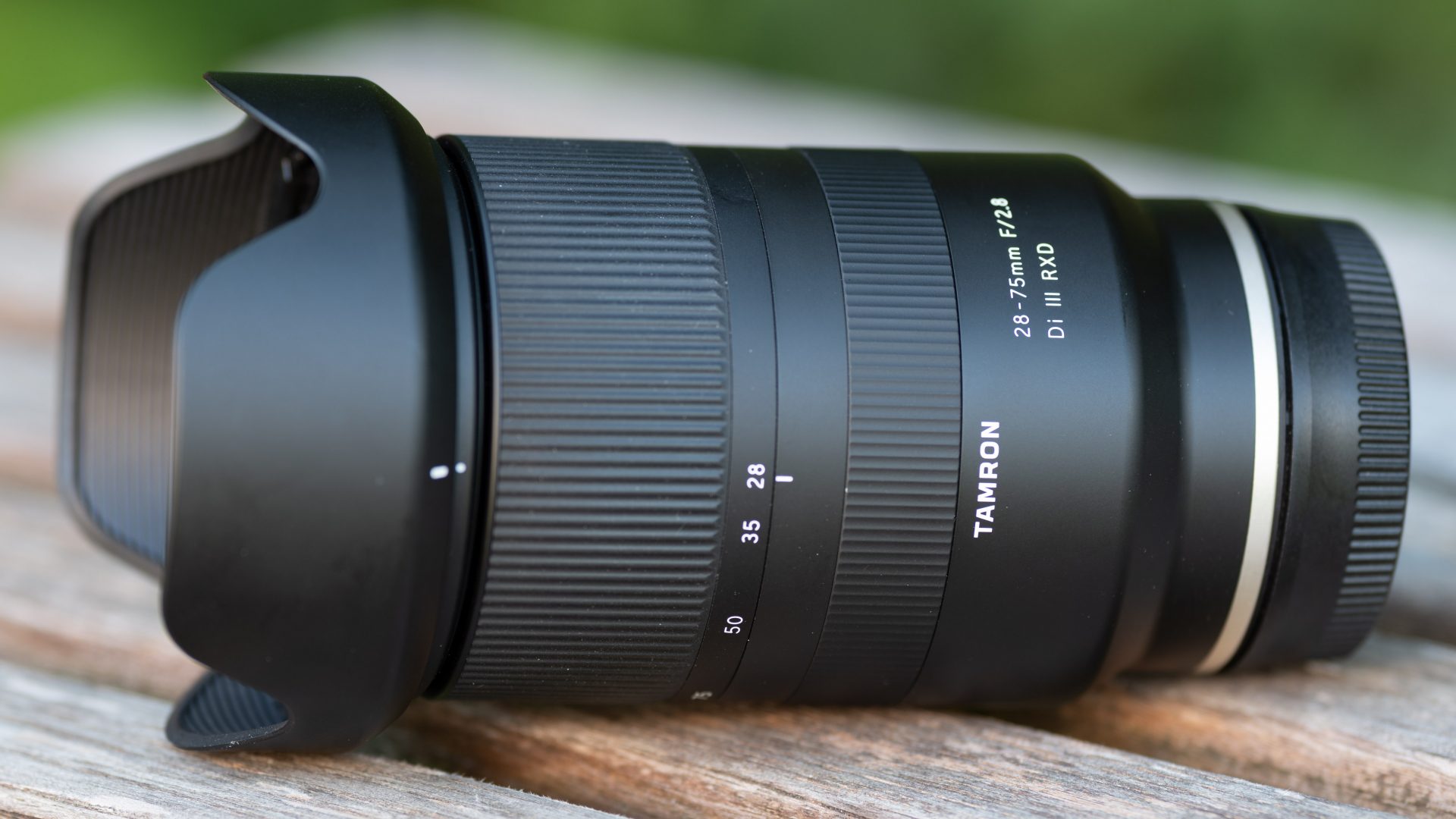
 The Tamron 28-75mm f2.8 is a valuable addition to the full-frame E-Mount market, that's wisely pitched between Sony's entry-level FE 28-70mm f3.5-5.6 kit zoom and the high-end FE 24-70mm f2.8 G Master. The Tamron is stunningly sharp in the APS-C image-circle and delivers very usable close-up performance too. It's small and light and comes at a reasonable price that makes it a viable option for those who can only dream of f2.8 zooms and were otherwise heading to the budget kit lens. For the price, the sharpness unsurprisingly becomes softer in the full-frame corners and many will miss the wider coverage of zooms that start at 24mm; there's also some irritating flare and ghosting under certain circumstances. But all-in-all the Tamron 28-75mm f2.8 is an attractive option for E-mount owners who want a step-up in aperture from the entry-level Sony FE 28-70mm f3.5-5.6 kit zoom without the considerable cost of the FE 24-70mm f2.8 G Master - and while it may become soft in the corners, subjects towards the middle will be sharp with the potential for attractive blurring behind them. So overall I'm happy to award Tamron's first native E-mount lens a recommendation!
The Tamron 28-75mm f2.8 is a valuable addition to the full-frame E-Mount market, that's wisely pitched between Sony's entry-level FE 28-70mm f3.5-5.6 kit zoom and the high-end FE 24-70mm f2.8 G Master. The Tamron is stunningly sharp in the APS-C image-circle and delivers very usable close-up performance too. It's small and light and comes at a reasonable price that makes it a viable option for those who can only dream of f2.8 zooms and were otherwise heading to the budget kit lens. For the price, the sharpness unsurprisingly becomes softer in the full-frame corners and many will miss the wider coverage of zooms that start at 24mm; there's also some irritating flare and ghosting under certain circumstances. But all-in-all the Tamron 28-75mm f2.8 is an attractive option for E-mount owners who want a step-up in aperture from the entry-level Sony FE 28-70mm f3.5-5.6 kit zoom without the considerable cost of the FE 24-70mm f2.8 G Master - and while it may become soft in the corners, subjects towards the middle will be sharp with the potential for attractive blurring behind them. So overall I'm happy to award Tamron's first native E-mount lens a recommendation!



